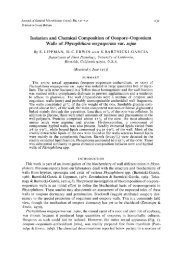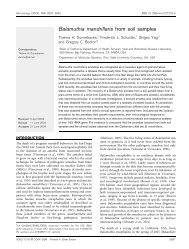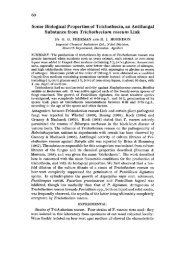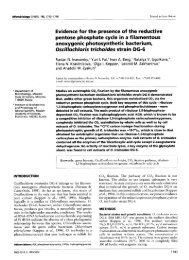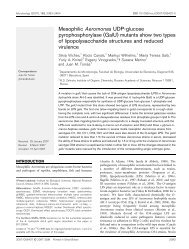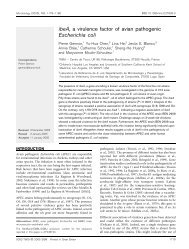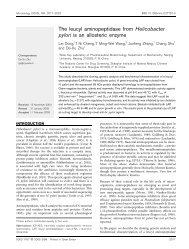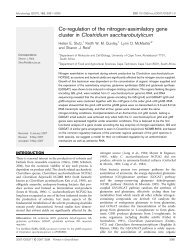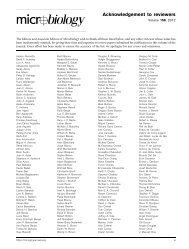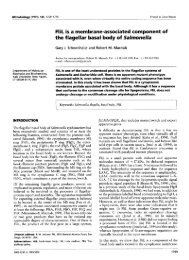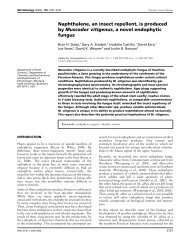The Characterization of Hyalochlorella marina gen. et ... - Microbiology
The Characterization of Hyalochlorella marina gen. et ... - Microbiology
The Characterization of Hyalochlorella marina gen. et ... - Microbiology
You also want an ePaper? Increase the reach of your titles
YUMPU automatically turns print PDFs into web optimized ePapers that Google loves.
<strong>Characterization</strong> <strong>of</strong> <strong>Hyalochlorella</strong> <strong>marina</strong> 185<br />
thickened walls by a series <strong>of</strong> events similar to those described above for Coccidioides.<br />
This developmental sequence is quite different from that reported by Goldstein &<br />
Moriber (1966) for their strains. In the above study I have been unable to confirm<br />
two <strong>of</strong> the observations reported by Goldstein & Moriber (1966). <strong>The</strong> vacuoplast is<br />
present only in stationary phase cultures and never in exponentially growing cells;<br />
when present, it occurs in less than 0-01 % <strong>of</strong> the developing sporangia and can<br />
therefore hardly be considered typical. I have also been unable to confirm their<br />
inference that growth is accompanied by the periodic liberation <strong>of</strong> individuals from<br />
their walls by ecdysis. During the compl<strong>et</strong>e development <strong>of</strong> single individuals (PI. 2),<br />
the only stage during which a wall is shed is at autospore liberation.<br />
<strong>The</strong> infrequent appearance <strong>of</strong> a vacuoplast, the possession <strong>of</strong> a mode <strong>of</strong> veg<strong>et</strong>ative<br />
cleavage different from that found in Derrnocystidium marinum, and the morphological<br />
and developmental similarities to Prototheca lead me to believe that these strains<br />
should not be placed in the <strong>gen</strong>us Derrnocystidium and to erect the new algal <strong>gen</strong>us<br />
Hy aloch lor ella.<br />
On the basis <strong>of</strong> morphology and development, <strong>Hyalochlorella</strong> is a colourless<br />
counterpart <strong>of</strong> the alga Chlorella and analogous to Prototheca. In addition to its<br />
mode <strong>of</strong> sporo<strong>gen</strong>esis, features it has in common with Chlorella are motile preauto-<br />
spores, variable numbers <strong>of</strong> autospores, and walls <strong>of</strong> high tensile strength. Hyalo-<br />
chlorella differs from Prototheca in discharging autospores sequentially and separately<br />
rather than as a clump, in lacking a pectinaceous ground substances in the mature<br />
sporangium, in possessing a large vacuole in all developmental stages except for the<br />
autospore and mature sporangium, and in the wall reaction with Ruthenium Red.<br />
All <strong>Hyalochlorella</strong> <strong>marina</strong> strains give a pectin positive reaction <strong>of</strong> variable in-<br />
tensity, whereas all strains <strong>of</strong> Prototheca give a negative reaction. Some Chlorella<br />
species give a positive Ruthenium Red reaction <strong>of</strong> varying intensity and some a<br />
negative reaction (Kessler & Soeder, I 962). Possibly, Prototheca is more closely<br />
related to the Ruthenium Red negative strains and <strong>Hyalochlorella</strong> to the Ruthenium<br />
Red positive strains.<br />
Hyachlorella <strong>marina</strong> <strong>gen</strong>. <strong>et</strong> sp.nov.<br />
Cellulae sine colore, in agaro nutriente colonias cremias fermentoideasque, margini-<br />
bus plerumque levibus, efficientes. Cellulae veg<strong>et</strong>ativae iuvenes (autosporea) uninucle-<br />
atae, membranam tenuem habentes, sphericae ad ovoideas, 4 ad 6.5 pm. diam.<br />
Reproductio asexualis per formationem autosporarum effecta. Crescentia formationem<br />
vacuolae eccentricae magnae implicat, deinde cellula crescit, simul nucleus se dividit.<br />
Sporangium immaturum sphericum, 7 ad 25 pm. diam., multinucleatum. Cytokinesis<br />
per fissionem multiplicem ad 2, 4, 8, 16, 32, 64, 128 vel 3, 6, 12, 24, 48 autosporas<br />
uninucleatas in omni sporangio formandas effecta. Autosporae ruptura laterali mem-<br />
branae sporangii liberatae. Protoplasti mobiles emer<strong>gen</strong>tes interdum observati.<br />
Omnes autosporae in culturis in periodo crescentiae immobili interdum e sporangio<br />
non emergunt ; aliquando nullae autosporae emergunt, ut sorum sporangiorum<br />
efficiatur. Membrana cellulae levis tenuisque, senescens non spissescens. Matrix gela-<br />
tinosa membranam circumdans nulla. Cellulae in cultura liquida non se cohaerentes.<br />
Reproductio sexualis non observata.<br />
<strong>The</strong> author expresses his appreciation to Dr D. Branton, Dr M. S. Fuller and<br />
Dr J. A. West for their interest and helpful suggestions during this study. He would



